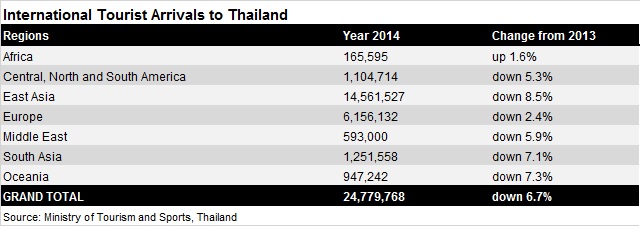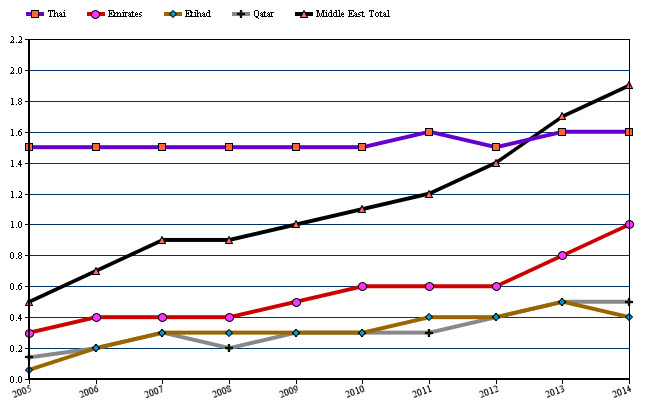Thai Airways’ planned capacity cuts on European routes this summer marks a turning point in the carrier’s history, as it faces a perfect storm of declining European tourist arrivals, a falling euro, and increasing pressure from Emirates, Etihad, and Qatar Airways.
Once upon a time, Thai’s European network was a powerful selling point. Although European carriers have long been present on Thai routes, their presence is dwarfed by Thai, which possessed good connectivity from Bangkok to others parts of Thailand.
On 19 March, however, it announced it would eliminate its Bangkok-Madrid service on 6 September. The carrier’s Bangkok-Frankfurt frequency was cut on 1 May, and its Bangkok London-Heathrow will be halved from twice daily to daily effective 1 July.
This followed news in late February that its net loss for 2014 had ballooned to Bt23 billion ($711 million), a ten-fold increase from 2013. At the time it complained of declining tourist arrivals from North Asia owing to political unrest in Thailand during the year, but capacity figures from Flightglobal’s Innovata Network Data service suggest that Europe was probably an even bigger headache during the year.
In May 2015, Thai served 14 European capitals, with its three biggest European routes being London Heathrow, Frankfurt, and Paris. In terms of capacity, Europe figures prominently in Thai’s network, accounting for 1.1 billion ASKs in May 2015, well ahead of Australia, but behind international ASKs from other countries in Asia.

Innovata
Furthermore, Innovata shows that Thai has kept capacity to Europe surprisingly static since 2005, providing 1.5 million inbound seats from Europe for most of the last ten years, with a slight surge to 1.6 million in 2011, followed by another surge in 2013. Hence, Thai’s moves to reduce or cut European services and reduce the size of its long-haul fleet represents a key turning point.
One problem is the sharply diminishing purchasing power of European tourists in Thailand. Although the euro reached a respectable exchange rate of Bt43.7 at the beginning of 2014, by October it had collapsed by 10% to Bt39.8. By end 2014 it was Bt37.9. In 2014 the European currency has been highly volatile: it now stands at Bt36.3 after plunging to Bt33.9 in April.
A weaker euro, along with Thailand’s capricious politics, could have had a role pushing European tourist arrivals down. Data from Thailand’s Ministry of Tourism and Sports says arrivals from Europe fell 2.4% to 6.2 million in 2014. Arrivals from other destinations also declined, but Europe is by far Thailand’s biggest arrivals market apart from East Asia.

As if all this is not enough, Innovata data shows that the combined Persian Gulf-Thailand capacity from Emirates, Etihad, and Qatar Airways has climbed to nearly two million seats in 2014, roughly 20% above Thai’s own capacity. The vast majority of this capacity was undoubtedly carrying transfer traffic from Europe, as Middle Eastern tourist arrivals in 2014 numbered just 593,000, less than one tenth of the European total.
While it is entirely possible that the Middle Eastern carriers, notably Emirates, may have lost money on Thai routes in 2014, there is little doubt that they have the financial muscle to stay in the European-Thai market for the long-haul.
Bangkok bound: Thai's capacity from Europe vs. Gulf carriers capacity from Middle East.

Innovata
Qatar and Etihad, moreover, rank as Bangkok Airways’ biggest two codeshare partners. Innovata shows that each carrier has 20 codeshare arrangements with the Bangkok-based carrier, effectively neutralising Thai’s network strengths.
A volatile Euro, slowing European tourist arrivals, and capacity growth from the Middle East will all serve to complicate Thai’s fighting retreat from Europe. The only thing missing (for the time being, anyway) is more upheaval in Thailand’s fraught political environment.
Source: Cirium Dashboard



















